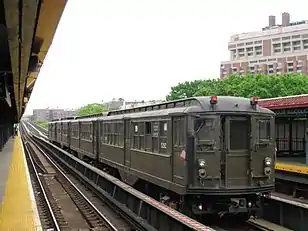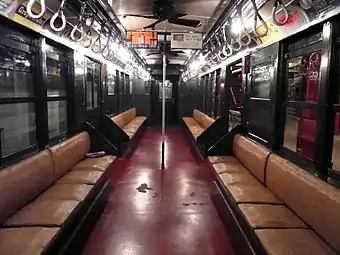Standard Lo-V (New York City Subway car)
The Standard Lo-V (an abbreviation for “Low-Voltage car”) was a New York City Subway car type built from 1916 to 1925 by the Pressed Steel Car Company, American Car and Foundry, and Pullman Company for the IRT. A total of 1,020 cars were built, which consisted of 725 motors and 295 trailers. It was the third "Lo-V" type car ordered for the IRT (after the Flivver Lo-Vs and the first Steinway Lo-Vs).[2]
| Standard Lo-V | |
|---|---|
 The four surviving "Low-Voltage" motor cars on layover on the IRT Jerome Avenue Line. | |
 Interior of a 1917 IRT Lo-V car. | |
| Manufacturer | Pressed Steel Car Company, American Car and Foundry, Pullman Company |
| Replaced | 1969 |
| Constructed | 1916–1925[1] |
| Number built | 1,020 cars (725 motors, 295 trailers) |
| Number preserved | 7 |
| Number scrapped | 1,013 |
| Fleet numbers | 4515–4554 (trailers) 4577–4699 (motors) 4719 (motor) 4772–4810 (motors) 4811–4965 (trailers) 4966–5302 (motors) 5303–5402 (trailers), 5403–5627 (motors) |
| Capacity | 196: 44 (seated) 152 (standing) |
| Operator(s) | Interborough Rapid Transit Company New York City Transit Authority |
| Specifications | |
| Car body construction | Steel |
| Car length | 51 ft 6 in (15.70 m) |
| Width | 8 ft 10 in (2,692 mm) |
| Height | 11 ft 10.5 in (3.62 m) |
| Floor height | 3 ft 2 1⁄8 in (0.97 m) |
| Doors | 6 |
| Maximum speed | 60 mph (97 km/h) |
| Weight | Motor car: 77,700 lb (35,200 kg) Trailer car: 56,000 lb (25,000 kg) |
| Traction system | Motor car: Westinghouse 577,General Electric 260 Trailer car: None Air Compressor: WABCO 2-C-Y |
| Prime mover(s) | electric motor |
| Power output | 200 hp (149 kW) (Wh 577) 195 hp (145 kW) (GE 260) per traction motor |
| Electric system(s) | 600 V DC Third rail |
| Current collection method | Top running Contact shoe |
| Braking system(s) | WABCO Schedule AMUE with UE-5 universal valve, ME-23 brake stand, and simplex clasp brake rigging |
| Coupling system | WABCO J |
| Headlight type | incandescent light bulbs |
| Track gauge | 4 ft 8 1⁄2 in (1,435 mm) |
Description
Lo-Vs were arranged in mixed trains consisting of trailer cars and motor cars. While trailer cars were equipped with brakes, but no air compressors or motors, motor cars were equipped with all three. "Lo-V" is short for "Low Voltage", which refers to the cars' form of propulsion control. Earlier Composite and "Hi-V" (High Voltage) equipment that ran on the IRT had utilized a 600 volt DC circuit that ran directly through the motorman's master controller to control the car's propulsion. The 600 volts was also trainlined through the whole train by the use of high voltage jumper cables, which had to be run between cars. However, Lo-V equipment used battery voltage (32 volts) in the motor control circuit to move high voltage (600 volts) contacts underneath the car, which would control the car's propulsion. Likewise, it would no longer be necessary to use 600 volt jumpers between the cars. This tremendously improved the safety of the equipment for both train crews and shop personnel alike.
Standard Lo-V cars also simplified braking for train crews. On IRT equipment, an electric brake could be utilized to synchronize a braking effort and apply each car's brakes simultaneously and uniformly throughout the train. This was different from operating strictly using air (pneumatically), which was less responsive, but would still stop the train albeit more slowly. Lo-V cars simplified the braking process. On earlier IRT equipment, the braking notches were different for a motorman, depending on whether or not he was operating electrically or pneumatically. On Lo-V cars, the notches were identical, regardless of whether or not the electric brake was active. The braking system on a Lo-V car is known as AMUE.
History
The Lo-Vs served much of their time on the Lexington Avenue express services and the Seventh Avenue–East 180th Street–Bronx Park express services, but appeared on virtually all other IRT lines during their careers. In 1960, a few cars were modified for operation on some BMT shuttle services, by adding extensions on their sides at floor level to fill in the wider platform gaps on the BMT; this lasted only for a year and a half.[3][4] After 48 years of service, most of the Lo-V cars were retired in 1963, spending their last days on the Lexington–Jerome line. Some cars, however, remained in service on the 7th Avenue–Lenox express until early in 1964. A handful number of trailer cars remained on the fragment of IRT Third Avenue Line in the Bronx to finish out their years, until November 3, 1969.[5]
Some Lo-Vs were converted into work cars following their retirement from revenue service. They were eventually replaced by retired SMEE cars converted into work cars and were eventually all scrapped.[6]
Preservation
- Car 4902 (trailer car) has been preserved by the New York Transit Museum and restored.
- Car 5290 (motor car) has been preserved by Railway Preservation Corp. and restored.
- Car 5292 (motor car) has been preserved by Railway Preservation Corp. and restored.
- Car 5443 (motor car) has been preserved by Railway Preservation Corp. and restored.
- Car 5466 (motor car) has been preserved by the Shore Line Trolley Museum in East Haven, Connecticut, and restored. It is modified with trolley poles and is used in various tourist rides around the museum.
- Car 5483 (motor car) has been preserved by Railway Preservation Corp. and restored.
- Car 5600 (motor car) has been preserved at the Trolley Museum of New York in Kingston, New York. It is currently undergoing a cosmetic restoration but is not currently operable.
See also
- Flivver Lo-V, a low voltage propulsion control IRT subway car built in 1915.
- Steinway Lo-V, a low voltage propulsion control IRT subway car built from 1915 to 1925.
- World's Fair Lo-V, a low voltage propulsion control IRT subway car built in 1938.
References
- https://www.nycsubway.org/wiki/The_Interborough_Fleet,_1900-1939_(Composites,_Hi-V,_Low-V)
- "www.nycsubway.org: The Interborough Fleet, 1900-1939 (Composites, Hi-V, Low-V)". www.nycsubway.org. Retrieved October 24, 2016.
- https://www.nycsubway.org/wiki/Chapter_3,_The_BMT#Section_D:_Strangers_On_The_BMT
- https://www.nycsubway.org/perl/show?24418
- "New York City Subway: Retired Rolling Stock". Oren's Transit Page. Retrieved August 12, 2020.
- https://www.nycsubway.org/wiki/Chapter_2,_The_IRT_Subway#Section_F:_Low_Voltage_Cars.2C_A_Milestone
- Gene Sansone, New York Subways: An Illustrated History of New York City's Transit Cars, ISBN 0-8018-7922-1, pp. 82 – 84, 86 - 94
- Interborough Fleet Joe Cunningham Xplorer Press